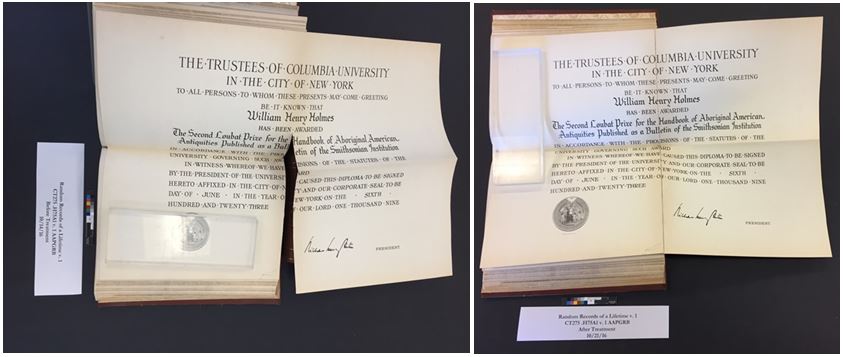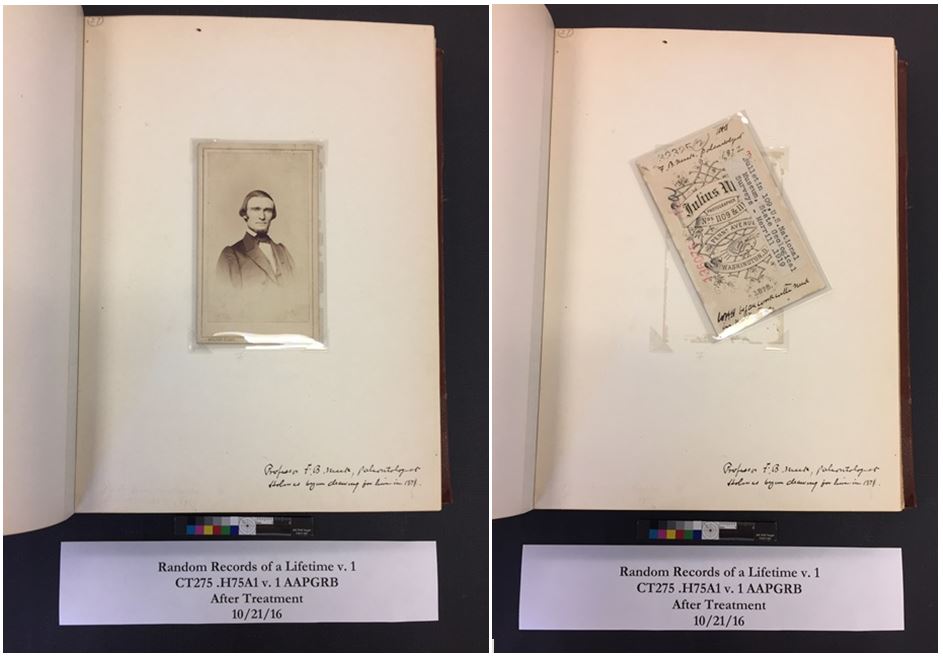In preparation for the December 1st, 2016 170th birthday of William Henry Holmes we repaired several of his “Random Records of Lifetime”. The repairs enabled the volumes to be digitization and included in the transcription project. This is volume 1 of his multi-volume memoir/scrapbook.
The volumes had many of the issues associated with scrapbooks – enclosures that were detached, loose photographs, larger fold out items that were broken at the folds and highly acidic newspaper clippings.

An interesting item that was detached was this list of the committee members of the Literary Society of Washington, D.C. from 1900-1901. The members include a Who’s Who of Washington society: Alexander Graham Bell, John W. Foster and E.M. Gallaudet. In order to read the entire pamphlet the decision was made to place it in a Mylar L-sleeve and attach the sleeve to the page. In this way the pamphlet may be removed for viewing and scanning purposes.

Oversized material proved a further challenge. Items such as certificates and prizes were folded and adhered along the edge to insert them in the volume. The adhesive used to adhere this certificate, for the Loubat Prize, proved difficult to remove without causing damage to the item. The decision was made to repair the torn edge in place using reversible wheat starch paste and Japanese paper.

There were multiple detached photographs in the volumes. This photo, of the geologist and paleontologist Fielding Bradford Meeks, was fully detached. Because of the information on the reverse side of the photograph we came up with a way to display the photo so that the back of it could also be accessed.

The photograph was placed in a Mylar L-sleeve and then attached to the volume using clear photo corners. This two part system ensures that the photo does not fall out of the Mylar sleeve but enable it to be carefully removed for viewing. The back of the photo reveals information about the photographer who took the portrait, an important detail for historians.

Finally, we encountered many newspaper clippings. Newspaper is made from inexpensive wood pulp that it is highly acidic and breaks down over time. The yellowing and brittleness you see in older newspaper is a sign of the paper deteriorating. In this case there is also significant offsetting, meaning that the acid has migrated onto the facing page of the text. Removing the newspaper proved problematic so a buffering tissue was placed between the clippings and the text.
There are many volumes of “Random Records of a Lifetime” and thanks to our efforts, and those of our talented in-house scanning department, these records are available online for your viewing. The scans have been further enhanced with transcription by hard-working Smithsonian Transcription Center volunteers. Have a look and discover the fascinating, multi-faceted person who was William Henry Holmes!

Be First to Comment